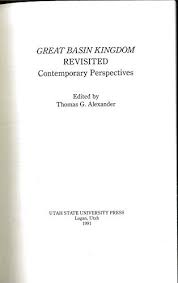Articles/Essays – Volume 25, No. 2
Reappraisal of a Classic | Thomas G. Alexander, ed., Great Basin Kingdom Revisited: Contemporary Perspectives
In May 1988, the Charles Redd Center for Western Studies at Brigham Young University and the Mountain West Center for Western Studies at Utah State University jointly sponsored an interdisciplinary symposium to reappraise, on its thirtieth anniversary, Leonard J. Arrington’s classic Great Basin Kingdom: An Economic History of the Latter-day Saints, 1830-1900 (Cam bridge: Harvard University Press, 1958). Though neither editor nor publisher of this collection of essays presented on that occasion offers any explanation for the frustrating three-year delay in its appearance, the collection is worth the wait.
The carefully chosen participants are major scholars in literature, history, eco nomics, sociology, anthropology, and geography. Since Arrington’s book studies Mormon history and institutions, we should expect most of its appraisers to be Mormon as well. But not the least of this collection’s assets is the presence of two card-carrying Gentiles—Donald Worster and Richard Etulain—whose fresh perspectives are sorely needed in the insular world of Mormon scholarship.
Like most collaborative projects, the essays vary considerably. Many contain personal reminiscences of Arrington and his book; however, geographer Ben Bennion and sociologist Stan Albrecht bolster their appraisals of limited themes in the book with original research presented here for the first time in tables, maps, and narrative. Donald Worster’s essay in intellectual history focuses on what he calls “the irrigation myth” (p. 30)—the notion that irrigation of arid lands creates not only a new agriculture, but a new people as well—a Mormon idea which he believes exists as an uncritically accepted assumption in Great Basin Kingdom.
Bennion, Albrecht, and anthropologist Mark Leone all explore the influence of Great Basin Kingdom on their disciplines and, even more important, reasons why the book has had a limited effect. Their conclusions, of course, vary, but Bennion’s invitation for increased communication and even collaboration among disciplines is implicit in most of these essays. If accepted, that invitation could well be the most significant achievement of the conference.
Are Mormon studies, as I alleged earlier, insular, incestuous, and intellectually sterile? Certainly the quality of the minds represented in this symposium indicate the possibility, at least, of creative, critical thought within the community of Mormon scholars. But in the concluding essay, “Beyond the Problems of Exceptionalist History,” Charles S. Peterson asserts that few Mormon studies since 1958 have followed Arrington’s precedent in relating Mormon history and institutions to the wider world of American thought and experience. Instead, Mormon scholars have hidden behind an assumption of Mormonism’s profound exceptionalism, defeating comparative studies and ab solving them of the obligation to relate their research to the larger world. Thus, meetings of the Mormon History Association attract only a few regular “token Gentiles,” and Mormon articles and mono graphs feature tightly focused studies of Mormon institutions and biographies of increasingly minor figures.
Editor Thomas G. Alexander takes up the cudgels against Peterson in his intro duction, as he does against no other contributor, but it is difficult to avoid concluding that Peterson has the best of the debate. The narrow range of publishers of the best recent Mormon monographs cited in Alexander’s footnotes and the limited circle of reviewers in Mormon periodicals strongly indicate that Mormon scholars are generally writing for each other.
If Peterson’s indictment of Mormon scholarship is at all valid, then young Mormon scholars could hardly do better than to dust off their copies of Great Basin Kingdom and try to fathom some of the genius of that great book. Along the way, they may find ways to connect Mormon studies once again with the nourishing bloodstream of American scholarship.
Great Basin Kingdom Revisited: Contemporary Perspectives edited by Thomas G. Alexander (Logan: Utah State University Press, 1991), 164 pp., index, $17.95.


 Back to full Issue
Back to full Issue

